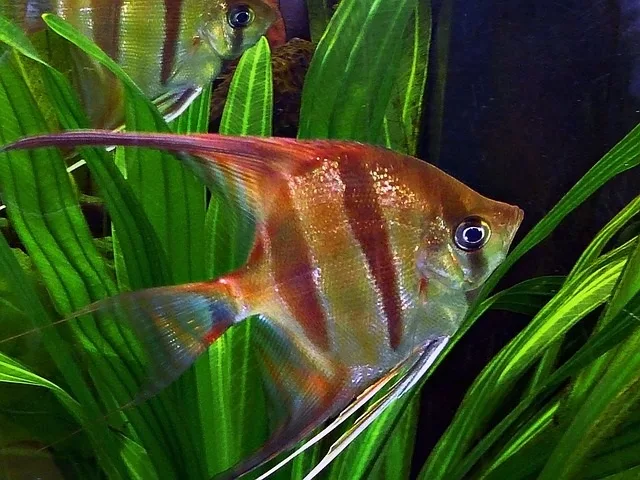
Top 25 Complementary Tank Mates for Angelfish in a Community Aquarium
Ideal tank mates for angelfish in a community tank Freshwater angelfish have gained significant popularity within the aquarium community due to their captivating attributes. These magnificent new-world cichlids are recognized for their impressive size, exquisite appearance, and the wide range of varieties and colors they exhibit. Observing an adult angelfish gracefully navigating a community tank is a sight to behold.
Nevertheless, it is essential to acknowledge the intricacies associated with these elegant creatures. Despite their allure, angelfish can display aggression in specific circumstances, potentially preying on smaller fish within the aquarium. Furthermore, their lengthy, flowing fins render them susceptible to harassment from semi-aggressive species and fin nippers.
Consequently, the utmost importance lies in carefully selecting suitable tank mates for angelfish. Optimal companions should exhibit peaceful behavior and possess a robust physique, dissuading any notion of becoming a potential meal.
For those embarking on their journey of angelfish keeping, familiarizing oneself with the essential care requirements is strongly advised before proceeding. Once adequately informed, this guide can serve as a valuable resource to aid in the selection of compatible tank mates for your angelfish.
How to Choose Tank Mates for Angelfish
Selecting fish that can thrive in the same or similar aquatic environments as your angelfish holds paramount importance. To meet this requirement, it is advisable to explore fish species originating from South America, particularly the Amazon River Basin, which serves as the natural habitat for wild freshwater angelfish.
However, the suitability of a fish as a suitable tank mate for angelfish extends beyond their geographic origin. Various factors necessitate consideration when choosing angelfish companions, encompassing the following:
Minimum Tank Size: While a thirty-gallon tank represents the minimum requirement, it is preferable to accommodate adult angelfish in larger tanks, such as 55 gallons or more. Such a tank size accommodates many of the fish species mentioned in this article, albeit not all. Furthermore, the total number of fish to be housed and their specific care requirements should also be factored in. Thorough research of each fish species is imperative prior to acquisition.
Adult Size: Familiarizing oneself with the eventual size of potential tank mates for angelfish serves two purposes. Firstly, it ensures that smaller fish do not become prey to larger ones, given that angelfish possess predatory tendencies. Secondly, it aids in determining whether the tank can adequately accommodate all desired fish species.
Temperament: Assessing a fish’s temperament, including its aggressiveness or docility, as well as the tendency to nip fins, is crucial. Even smaller fish can pose a threat to adult angelfish through harassment and fin-nipping. Employing effective tank management strategies can often mitigate such issues, although not always. Therefore, comprehensive knowledge about a fish species is indispensable prior to acquisition to prevent unwelcome conflicts within the aquarium.
Social Requirements: Certain fish thrive best when kept individually, while others prefer pairs or schools comprising six or more members. This consideration impacts not only the number of fish to be housed but also influences the overall stress levels experienced by the fish. Hence, such social requirements should inform decision-making, ensuring a harmonious environment for all occupants of the tank.
Care Level: It is pertinent to note that some fish species mentioned in this article are better suited for experienced aquarists. While this is subjective, it is strongly advised to evaluate one’s skill level and experience as a fishkeeper before acquiring fish. Beginners can find numerous fish species suitable for their proficiency level.
While perusing the remaining sections of this article, it may become apparent that certain advice is deliberately broad. This approach is intentional, as one of the pitfalls for novice aquarium owners is blindly following an author’s recommendations without due consideration. Instead, it is preferable to provide the necessary information to empower individuals to make informed decisions based on their own judgment.
Therefore, the fish species mentioned should be regarded as suggestions based on the author’s personal experience and knowledge. Ultimately, the responsibility lies with the individual to select the most suitable tank mates for their angelfish. Investing time and effort into acquiring extensive knowledge before obtaining fish will prove worthwhile.
List of Best Tank Mates for Angelfish
Below are 25 suitable tank mates for angelfish:
- Corydoras Catfish
- Black Skirt Tetra
- Bleeding Heart Tetra
- Hatchetfish
- Discus Fish
- German Blue Ram
- Electric Blue Ram
- Bolivian Ram
- Silver Dollar
- Common Plecostomus
- Rubbernose Pleco
- Bristlenose Pleco
- Neon Tetra
- Cardinal Tetra
- Otocinclus Catfish
- Platies
- Swordtails
- Mollies
- Three-spot Gourami
- Dwarf Gourami
- Boeseman’s Rainbow Fish
- Synodontis Catfish
- Kribensis Cichlids
- Keyhole Cichlids
- Kuhli Loach
It’s important to note that this list is not ranked in any particular order. The compatibility of each fish with angelfish depends on various factors. To make an informed decision, it’s advisable to gather more information about each species and consider whether they are suitable for your specific tank setup.
- Corydoras Catfish:
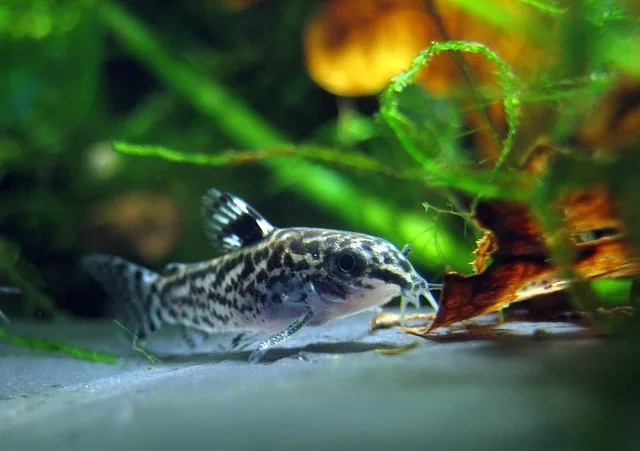
- Minimum Tank Size: 10 gallons
- Adult Size: 2-3 inches
- Temperament: Peaceful, social
- Social Requirements: Prefer to be kept in small groups
- Care Level: Easy
Corydoras catfish are popular bottom-dwelling fish known for their charming appearance and habit of scavenging. They are peaceful and get along well with other fish species, making them excellent community tank inhabitants.
- Black Skirt Tetra:
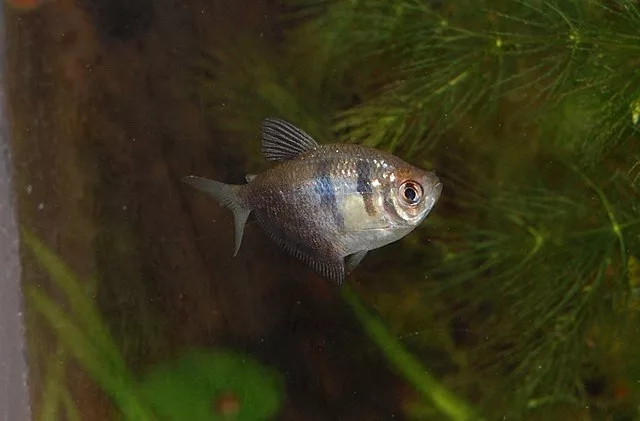
- Minimum Tank Size: 20 gallons
- Adult Size: 2.5 inches
- Temperament: Peaceful, semi-aggressive during feeding
- Social Requirements: Prefer to be kept in small groups
- Care Level: Easy
Black Skirt Tetras are attractive, active fish with flowing black fins. While they are generally peaceful, they may become slightly aggressive during feeding times. Keeping them in a group of five or more will help them feel secure and reduce aggression.
- Bleeding Heart Tetra:
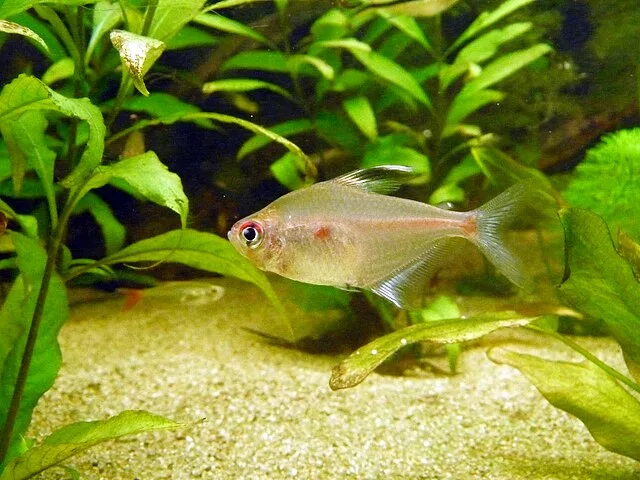
- Minimum Tank Size: 20 gallons
- Adult Size: 2.5-3 inches
- Temperament: Peaceful
- Social Requirements: Prefer to be kept in small groups
- Care Level: Moderate
Known for their vibrant red coloration and distinct heart-shaped pattern, Bleeding Heart Tetras add a splash of color to any aquarium. They are peaceful and should be kept in groups to ensure their well-being and minimize stress.
- Hatchetfish:
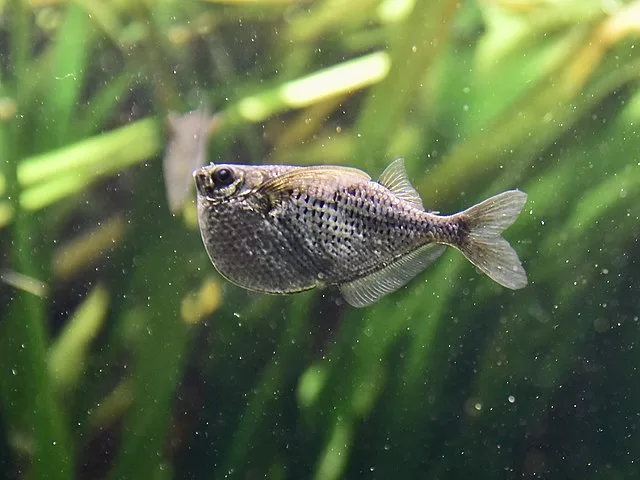
- Minimum Tank Size: 10 gallons
- Adult Size: 1.5-2.5 inches
- Temperament: Peaceful
- Social Requirements: Prefer to be kept in small groups
- Care Level: Moderate
Hatchetfish are unique due to their distinctive body shape, resembling a hatchet or a silver arrow. They have the ability to jump, so it’s important to keep the aquarium well-covered. Hatchetfish are schooling fish and thrive in groups of six or more.
- Discus Fish:
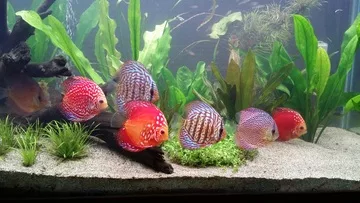
- Minimum Tank Size: 50 gallons
- Adult Size: 6-8 inches
- Temperament: Peaceful
- Social Requirements: Prefer to be kept in pairs or small groups
- Care Level: Advanced
Discus fish are often considered the crown jewels of the freshwater aquarium. They are known for their stunning colors and elegant swimming patterns. Discus fish require stable water conditions and high water quality, making them suitable for experienced aquarists.
- German Blue Ram:
- Minimum Tank Size: 20 gallons
- Adult Size: 2 inches
- Temperament: Peaceful, can be territorial during breeding
- Social Requirements: Prefer to be kept in pairs
- Care Level: Moderate
German Blue Rams are beautiful dwarf cichlids with vibrant blue coloration. They are generally peaceful, but males can become territorial during breeding. Providing them with plenty of hiding spots and suitable tank mates is important for their well-being.
- Electric Blue Ram:
- Minimum Tank Size: 20 gallons
- Adult Size: 2 inches
- Temperament: Peaceful, can be territorial during breeding
- Social Requirements: Prefer to be kept in pairs
- Care Level: Moderate
Electric
Blue Rams are a stunning variant of the German Blue Ram, known for their intense electric blue coloration. They possess the same temperament and social requirements as their German Blue counterparts. These fish can be a delightful addition to a peaceful community tank or a dedicated cichlid setup.
- Bolivian Ram:
- Minimum Tank Size: 30 gallons
- Adult Size: 3 inches
- Temperament: Peaceful, can be territorial during breeding
- Social Requirements: Prefer to be kept in pairs or small groups
- Care Level: Easy
Bolivian Rams, often referred to as the Bolivian Butterfly Ram, are hardy and well-suited for beginner aquarists. With their bright yellow-orange and blue markings, they add a burst of color to the aquarium. They are peaceful, but territorial during breeding, so providing adequate hiding spaces is important.
- Silver Dollar:
- Minimum Tank Size: 75 gallons
- Adult Size: 6-8 inches
- Temperament: Peaceful, can be skittish
- Social Requirements: Prefer to be kept in small groups
- Care Level: Easy
Silver Dollars are large, disk-shaped fish with a shiny silver body. They are peaceful in nature but can be easily startled, so it’s essential to create a secure and spacious environment for them. Keeping them in groups of five or more will help them feel more comfortable.
- Common Plecostomus:
- Minimum Tank Size: 100 gallons
- Adult Size: 12-24 inches
- Temperament: Peaceful
- Social Requirements: Prefer to be kept alone
- Care Level: Easy
Common Plecostomus, also known as Plecos or Suckermouth Catfish, are popular algae eaters in the aquarium hobby. They have a unique appearance with their armor-like body and large mouth. While peaceful, they require ample space and are best kept as the sole representative of their species in the tank.
- Rubbernose Pleco:
- Minimum Tank Size: 30 gallons
- Adult Size: 4-6 inches
- Temperament: Peaceful
- Social Requirements: Prefer to be kept alone or in small groups
- Care Level: Easy
Rubbernose Plecos, named for their fleshy and flexible snout, are excellent algae eaters. They have a mottled pattern and are peaceful inhabitants. Keeping them in small groups or as a solitary fish allows them to thrive without territorial issues.
- Bristlenose Pleco:
- Minimum Tank Size: 20 gallons
- Adult Size: 4-5 inches
- Temperament: Peaceful
- Social Requirements: Prefer to be kept alone or in small groups
- Care Level: Easy
Bristlenose Plecos are well-known for their bushy “bristles” on their face, which are more pronounced in males. These hardy fish are efficient algae eaters and can be a valuable addition to a well-maintained aquarium. They prefer a cave or hiding spot in the tank and appreciate a variety of food sources.
- Neon Tetra:
- Minimum Tank Size: 10 gallons
- Adult Size: 1-1.5 inches
- Temperament: Peaceful
- Social Requirements: Prefer to be kept in small groups
- Care Level: Easy
Neon Tetras are tiny, vibrant fish with a striking blue and red coloration. They are peaceful, schooling fish that require the company of their own kind to feel secure. A well-planted aquarium with subdued lighting will enhance their natural beauty.
- Cardinal Tetra:
- Minimum Tank Size: 10 gallons
- Adult Size: 1.5 inches
- Temperament: Peaceful
- Social Requirements: Prefer to be kept in small groups
- Care Level: Easy
Cardinal Tetras are closely related to Neon Tetras and share a similar appearance. They have a stunning red stripe running the length of their body, which creates a captivating contrast against their silver coloration. Like Neon Tetras, Cardinals thrive in groups and should be kept in a well-established aquarium with suitable water conditions.
- Otocinclus Catfish:
- Minimum Tank Size: 10 gallons
- Adult Size: 1.5-2 inches
- Temperament: Peaceful
- Social Requirements: Prefer to be kept in small groups
- Care Level: Easy
Otocinclus Catfish, often called Otos or Dwarf Suckermouth Catfish, are small and efficient algae eaters. They are peaceful and prefer to live in groups. These catfish can be a great addition to a planted aquarium, where they help control algae growth.
- Platies:
- Minimum Tank Size: 10 gallons
- Adult Size: 2-3 inches
- Temperament: Peaceful
- Social Requirements: Prefer to be kept in small groups
- Care Level: Easy
Platies are colorful and active livebearers that come in a variety of striking color combinations. They are peaceful and easy to care for, making them popular choices for beginner hobbyists. Platies are social fish and prefer to be kept in groups of their own kind or with other peaceful community fish.
- Swordtails:
- Minimum Tank Size: 20 gallons
- Adult Size: 4-6 inches
- Temperament: Peaceful, males can be slightly aggressive
- Social Requirements: Prefer to be kept in small groups
- Care Level: Easy
Swordtails are known for their distinct elongated tail fins, resembling a sword. They are peaceful in nature but males can display minor aggression towards each other. Keeping a single male with multiple females is a recommended setup to minimize territorial disputes.
- Mollies:
- Minimum Tank Size: 20 gallons
- Adult Size: 3-4 inches
- Temperament: Peaceful
- Social Requirements: Prefer to be kept in small groups
- Care Level: Easy
Mollies are lively and versatile fish that adapt well to various water conditions. They come in a range of colors and patterns, adding vibrancy to any tank. Mollies are social and thrive when kept in small groups or as pairs.
- Three-spot Gourami:
- Minimum Tank Size: 30 gallons
- Adult Size: 4-5 inches
- Temperament: Peaceful, males can be territorial
- Social Requirements: Prefer to be kept in pairs or small groups
- Care Level: Easy
Three-spot Gouramis are attractive labyrinth fish with a black spot on their body and two spots on their fins. They are generally peaceful, but males can exhibit territorial behavior, especially during breeding. Providing plenty of hiding places and breaking the line of sight in the tank can help reduce aggression.
- Dwarf Gourami:
- Minimum Tank Size: 10 gallons
- Adult Size: 2-3 inches
- Temperament: Peaceful, males can be territorial
- Social Requirements: Prefer to be kept in pairs or small groups
- Care Level: Easy
Dwarf Gouramis are popular for their vibrant colors and peaceful nature. They are available in various color variations, adding visual interest to the aquarium. It’s important to maintain a balanced male-to-female ratio or keep a single male to prevent territorial conflicts.
- Boeseman’s Rainbow Fish:
- Minimum Tank Size: 30 gallons
- Adult Size: 3-4 inches
- Temperament
: Peaceful, can be slightly territorial during breeding
- Social Requirements: Prefer to be kept in small groups
- Care Level: Easy
Boeseman’s Rainbow Fish, also known as Boesemani Rainbow Fish, are known for their vibrant and iridescent colors. They have a peaceful temperament, but males can become territorial during breeding. To maintain a harmonious tank, it is recommended to keep them in small groups with ample swimming space and hiding spots.
- Synodontis Catfish:
- Minimum Tank Size: 50 gallons
- Adult Size: Varies depending on species
- Temperament: Peaceful
- Social Requirements: Prefer to be kept in small groups, species-dependent
- Care Level: Moderate
Synodontis Catfish are a diverse group of catfish known for their interesting patterns and behaviors. Their adult size varies depending on the species, ranging from a few inches to over a foot in length. They are generally peaceful, but some species may exhibit minor territorial behavior. Researching the specific species’ social requirements is crucial for their optimal care.
- Kribensis Cichlids:
- Minimum Tank Size: 20 gallons
- Adult Size: 3-4 inches
- Temperament: Peaceful, can be territorial during breeding
- Social Requirements: Prefer to be kept in pairs or small groups
- Care Level: Easy
Kribensis Cichlids, also called Kribs, are small and colorful cichlids originating from West Africa. They have striking red and blue coloration and are known for their interesting courtship and breeding behaviors. While they are generally peaceful, they can become territorial during the breeding period. Providing ample hiding spots and suitable tank mates is essential for their well-being.
- Keyhole Cichlids:
- Minimum Tank Size: 30 gallons
- Adult Size: 4-5 inches
- Temperament: Peaceful, shy
- Social Requirements: Prefer to be kept in pairs or small groups
- Care Level: Easy
Keyhole Cichlids, named for the distinctive black spot on their sides, are peaceful and shy fish. They prefer well-planted aquariums with subdued lighting and peaceful tank mates. Keyhole Cichlids form strong pair bonds and can be kept in pairs or small groups.
- Kuhli Loach:
- Minimum Tank Size: 20 gallons
- Adult Size: 3-4 inches
- Temperament: Peaceful, nocturnal
- Social Requirements: Prefer to be kept in small groups
- Care Level: Easy
Kuhli Loaches are eel-like fish with a unique appearance and nocturnal behavior. They are peaceful and spend most of their time burrowing and hiding in the substrate. Due to their social nature, it’s best to keep them in small groups of at least three or more.
When selecting fish varieties for your aquarium, it’s important to consider their minimum tank size, adult size, temperament, social requirements, and care level. Providing an appropriate environment and companionship ensures the well-being and happiness of your aquatic pets. Remember to research each species thoroughly and consult with experienced aquarists or professionals to create a thriving and harmonious underwater world. Happy fishkeeping!
Frequently Asked Questions about Angelfish Tank Mates
Presented below are responses to common inquiries regarding angelfish and their compatibility with other fish species in an aquarium setting.
- What is the typical size of angelfish? Angelfish can reach heights of up to a foot, measured from the bottom of their ventral fins to the top of their dorsal fin. However, in larger home aquariums, adult angelfish generally grow to around six to eight inches in height.
- How many angelfish can coexist in the same tank? In spacious tanks, it is recommended to keep angelfish in schools of six or more under the supervision of an experienced fishkeeper. However, due to the territorial nature of angelfish, particularly when paired, many aquarium owners opt to keep a single angelfish.
- Can tetras be housed with angelfish? While it is possible to keep tetras with angelfish, it is crucial to consider the compatibility factors. Certain tetra species, such as neons, are small enough to be consumed by angelfish, while others may exhibit fin-nipping behavior that can distress angelfish. It is essential to conduct thorough research and acknowledge the associated risks before deciding to house tetras and angelfish together.
- Is it advisable to keep oscars with angelfish? Typically, oscars and angelfish are not recommended as tank mates. Oscars are large and aggressive fish, and although skilled aquarists may succeed in maintaining a harmonious coexistence in very spacious tanks, most fishkeepers should avoid pairing angels with oscars.
- Can a single angelfish be kept in a community tank? Certainly, it is possible to keep a solitary angelfish in a community tank, which can be a prudent choice for novice and intermediate aquarium owners. While angelfish naturally reside in schools in the wild, managing their behavior in a home aquarium can be challenging.
- What bottom feeders can coexist with angelfish? Angelfish can potentially cohabitate with various catfish and bottom feeders, including:
- Cory catfish
- Common Plecostomus
- Rubbernose Pleco
- Bristlenose Pleco
- Kuhli Loach
- Can angelfish be housed with cichlids? Under suitable circumstances, angelfish can coexist with peaceful South American cichlids, such as discus fish and Bolivian rams. However, they should not be paired with aggressive new-world or African cichlid species.
- Do angelfish pose a threat to other fish? Angelfish possess the potential to harm or even kill other fish. Depending on the circumstances, they may prey on or exhibit aggression towards other fish due to territorial instincts. It is crucial to carefully consider the choice of fish species that will cohabitate with angelfish.
Thoughtful Consideration in Selecting Angelfish Tank Mates
Throughout my experience with angelfish, I have encountered both amiable and aggressive individuals. While some angelfish exhibited docile behavior and peacefully coexisted with other tank inhabitants, others displayed aggression and constantly sought conflict.
In fact, one particularly aggressive angelfish compelled me to acquire an additional tank solely for its isolation from other fish. From then on, it resided alone, earning it the lighthearted nickname of being “in jail” from my wife. Reflecting on this experience, there are insights I have gained that could have significantly enhanced the well-being of my fish and facilitated my own aquarium management.
I always emphasize that my articles are founded on personal experiences, research, and knowledge. Just like you, I am continually learning and evolving.